There are all types of “satin” fabrics out there, and many of them are well-suited to hand embroidery.
Satin, just to make it clear from the start, is a weave. It doesn’t refer to the fiber make-up of the fabric, but to the weave of the fabric. Satin fabric (unless it’s double-faced) is normally dull on one side of the fabric and shiny on the other.
Good satin made with natural fibers will often have a nice body to it – it’s not slick, limp and slippery. Rather, it’s a little stiffish, but “buttery” in a way. Smooth, easy to cut, substantial – it just feels good.
Silk satin, cotton satin (or sateen), and some natural fiber blends (silk / cotton and silk / wool) in satin weave are all suitable for hand embroidery, and all of them have one thing in common that you might want to be aware of before you start working with them:
They roll and shed.
The cut edges of most satin fabrics tend to roll up, making it a little more difficult and fiddly to mount satin fabric on an embroidery frame. They also tend to shed wispy bits of thread that can catch in your embroidery.
Today, I’m going to show you a quick cheat for working with fabrics that have a tendency to roll and shed on the edges.
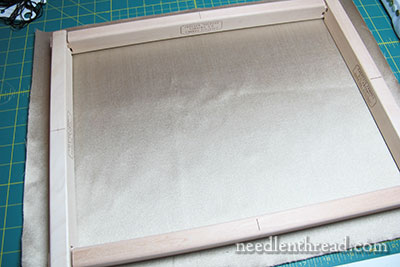
Here’s my satin fabric. This is a silk / wool blend, in a champaign-gold. It’s a beautiful fabric – substantial, with a gorgeous hand (it feels So Nice!), and it cuts beautifully. It also takes stitches really well. You can see some examples of this fabric in use with embroidery here.
I’ve cut a piece of the satin out, so that it is at least an inch larger than my embroidery frame on all sides.
The fabric itself is at least three inches larger than my stitching area on all sides. It sounds like a lot of waste (six inches wider and six inches taller than the design area), but the excess is necessary for at least two reasons:
1. The excess allows plenty of room to frame up the piece for stitching, while still allowing enough room inside the frame for comfortable stitching. There’s nothing worse than an embroidery frame that’s too close to the embroidery. You end up not being able to manipulate your needles next to the edge, or get little scissors in where you might need them, and so forth.
2. The excess allows plenty of space for finishing options – mounting for professional framing, sewing into items, and so forth.
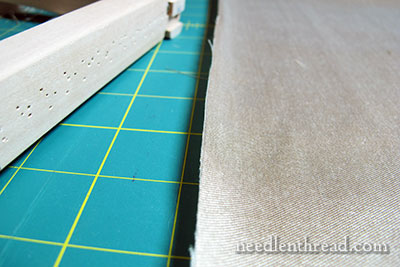
You can see here how the edges of the satin curl up. This is right after cutting. Over time, it will curl a little more. Depending on your the type and weight of the satin, the edges may have even more curl. On some silk satins, the edges will curl into tight little rolls.
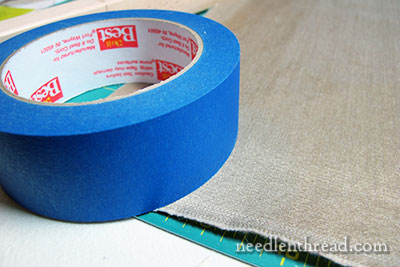
Taping the edges of fabric is not something new. I don’t do it on long term projects, but I do use tape on short term projects.
For long-term projects that may be on the frame a while, or where the waste won’t be cut off for a while, there are more labor intensive approaches that work for taming curling edges.
For example, using a machine, you can sew the edges of the fabric to twill tape before mounting it on stretcher bars or onto a slate frame. I prefer this method if I’m going to be working on a project long-term, and especially if I’m going to be using a slate frame.
But for quick preparation for short-term projects, low-tack masking tape or low-tack painter’s tape comes in really handy.
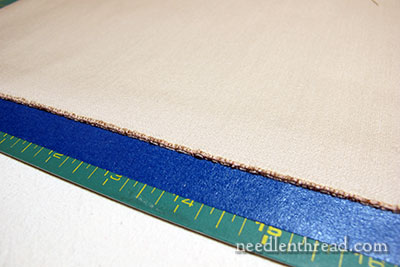
First, I cut the tape just a little longer than the length of the edge of the fabric I’m covering.
I lay the tape on my table (usually on my cutting mat, so I can keep things nice and straight), with the sticky side up.
Then, line up the edge of the fabric nice and straight, leaving a half inch overhang of exposed tape, and, pressing from the center out to the outside edges along the length of the tape, adhere one edge of the fabric to the tape.
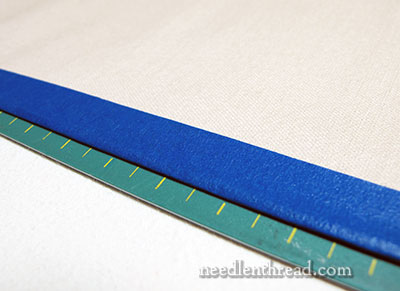
Next, fold the remaining exposed tape up over the edge of the fabric, finger pressing it to the fabric from the center to the outside edges.
Do this all the way around, trimming excess tape off the corners.
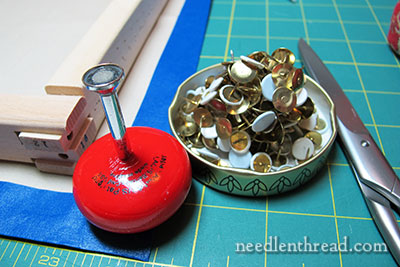
Next up – tacking! There’s a handy dandy tool set for tacking fabric to stretcher bar frames, called E-Z Tack It – if you use stretcher bar frames often, you should invest in one of these tool kits! It makes tacking and untacking super-duper easy.
I’m using Evertite stretcher bars. They’re my go-to stretcher bars, and over the years, I’ve collected them in pretty much all the sizes available. I’ve been using and re-using them (and re-using them again) for a long time, and they’ve been utterly worth the investment.
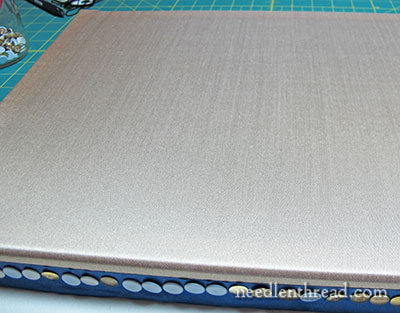
Tack the fabric onto the frame, working from the center of one side of the frame out to the edge. Return to the center of that side of the frame and tack out to the edge. Tack right through the tape!
Then repeat with the opposite side of the frame, and then with the other two sides of the frame, pulling your fabric taut as you tack, but not warping it. It won’t get really taut until you tack the final side of the frame.
With the Evertite frames, you can then tighten the corners (as explained in this tutorial on setting up an Evertite frame), and your fabric will be….oooooooh. Perfect for stitching!
And the edges of your satin fabric will not shred and will not curl, because they’re all taped up! It’s a great little method for quickly neatening the edge of your embroidery fabric for short term projects that are mounted on stretcher bar frames.
As always, you’re welcome to ask questions or make suggestions below!







You are a true witch 🙂 thanks, this is really helping
Dear Mary,
Thanks for the information and how-tos, past, present, and future. Why did you say to use the low-stick tape only with short term projects? With the tacks spaced so close together on the Evertite, would it really matter if eventually the tape came unstuck and brittle? As always, I appreciate your thoughts.
Well, the tape can become brittle. It can also gum up in warmer stitching environments. It also seems to be a dirt and dust magnet, if it loosens from the fabric. I just don’t like leaving tape on fabric for a long time. But you do have a good point about the closeness of the tacks. I suppose it wouldn’t matter in the long run, if the tape with the fabric sandwiched in between is left on longer. But I prefer the reliability of a sewn edge (with twill tape) for something that’s going to be set up for embroidery for a long time.
Mary,
Even your framing techiniques are immpeciable.
I’m having a difficult time finding satin locally and online-where do you find your satin?
New York Fashion Center Fabrics, lately. I used to buy them from a more “local” shop in KC (2 or so hours from here), but they’ve since closed. So now I keep a swatch book and order online.
So you used the silk/wool blend from them? Have you successfully stitched on the Duchesse?
Yes, this is the blend. I like it a little better than duchesse satin or silk satin, only because it doesn’t have that tendency to split when the needle enters the fabric. Sometimes, you can get tiny runs in this kind of silk. You don’t get that with the blend. And, if I use a micron pen to transfer, it doesn’t bleed like it does on silk satin.
Good morning, Mrs. Corbet, I hope it’s not as hot in Kansas as it was over the weekend. I have quite a few questions about this article so I hope you won’t mind too much…
1. What exactly is your definition of a, “Long-term Project?” For me, a project can last anywhere from two weeks to ten years!
2. Will your wondrous taping method work for those of us who do not have frames? I don’t think I’ll be able to afford one any time soon.
3. When using fabrics like satin, which do you prefer, a natural cotton, or silk? Can flax be woven as a satin?
Thanks for your patience, and I hope the Hummer problem gets worked out soon, although I still adore him as is.
1. Long term: Something that is on the frame longer than a week or so, I suppose.
2. I wouldn’t use it for hooped fabric. I think it would be too awkward to hold the stiffer taped edges, and the heat of your hand could gum up the tape a bit.
3. I prefer silk satin. Next up would be a silk / wool or silk / cotton blend. (Although, right now, I’m really liking the blend in the article above…) To my knowledge, flax is not woven as satin. Cotton is mercerized to provide the satin sheen, but linen (or flax) is not mercerized, and it doesn’t really have a sheen. Linen is woven into twill, though, which also makes a nice ground for embroidery.
Thank you so much for taking the time to answer my questions, Mrs. Corbet. I admit, the answer on #2 makes me a bit sad, but I am glad to have more knowledge. One more question that I forgot as I was typing…
At my local craft store they had a selection of “Cross Stitch” fabrics, and I’m wondering what’s the difference between good frabrics for embroidery, and Cross Stitch?
I do both, but I prefer embroidery.
You can tell by looking at fabric whether or not it is suitable for cross stitch. Cross stitch fabric has a definite grid to it, often with a slightly more open weave, so that you can easily see the holes. Normally the stuff sold at craft stores is “Aida” cloth, which is a fabric woven in little blocks that mimic the grid on a cross stitch pattern. It can be 100% cotton, or it can be a cotton / poly blend, or completely synthetic. If you’re going to put a lot of time into a cross stitch project that you want to withstand the test of time, I’d encourage you to look for an even-weave linen rather than Aida cloth. Remember that the most expensive thing you’ll put into your embroidery is your time. The cost of supplies when compared the hours of time put into needlework is negligible.
Mrs. Corbet,
I’m thinking that I need to get an Evertite frame sometime soon. Can you tell me, where did you get yours and how much do they cost? Thanks!
Sarah 😀
You can find them at Needle in a Haystack (online – in California) or Stitcher’s Paradise (also online – located in Florida). I believe the prices at Stitcher’s Paradise are a little bit less expensive. The cost varies, depending on the sizes you buy. Just remember that they’re sold as pairs and you have to have two pairs!
Dear Mary
I’m currently starting a project for a 50th birthday and I am going to embroider on linen and appliqué to silk I hadn’t thought to embroider directly on to silk fabric because I thought it would be to difficult, but what a great technique, I can see that the e-z tack it kit is a great accessory just what you need for stretcher bars. Would the tape technique work for short projects with silk fabric or linen fabric on the millennium frame I wonder? Thanks so much for this article and taking the time to show us how to frame up satin fabric on stretcher bars very useful.
Regards Anita Simmance
No, I wouldn’t use it for the Millenium frame. The tape on the sides would increase the thickness of the edge in the slot on the rollers – in fact, I don’t know that it would fit, folded, in there…
Dear Mary
Thanks for your reply and the tip, yes you are right I hadn’t thought of that.
Regards Anita Simmance
Mary, this question is not about the satin fabric preparation. Instead I have a couple question regarding the System 4. If it is OK may I correspond with you via email? Thanks in advance.
Patty
Mary, I’ve been following your discussion on framing satin fabric; I was wondering if you had considered sealing the edges of the satin with a lighter before using low tack painters tape? This method of running a lighter along the edges is something I have done in my other crafting to prevent curling or fraying of the edges. I thought it may help to do this before taping and framing to prevent pulls and fraying once the frame and tape are removed. Have you tried this with any success? Is this another good way to secure those beautiful buttery satin fabrics?
The satin looks beautiful! I saw someone stitching the Secret Garden hummingbirds on a satin-y looking fabric and have been wanting to try it ever since.
When using the Evertite frames do you loosen the fabric at the end of each stitching session like you would take your fabric out of your hoop every time? Or can your project stay taut for weeks?
Thanks so much!
No, no need to loosen the frame…
Hi Mary!
I’m so excited to see this article. I have a few questions for you about the silk blend. I have stitched on the Duchesse, and I have found that stretching the Duchesse on the Evertites leaves a grid of stretch marks where the tacks go in. And I’ve definitely seen those little splitty marks where the needle goes in that you’ve mentioned, and I’d love to eliminate both of these aspects on the finished project.
1.) If the silk blend appears to minimize the splitty marks where the needle pierces the fabric, does it also take care of the faint grid lines where the Evertite tacks go in?
2.) Is it a matter of putting in more tacks closer together, or do you think that will just make a smaller grid?
3.) Or am I overstretching/over-tightening?
What do you think? I really love the sheen and feel of the Duchesse. It’s extraordinary, really, but the devil is in the details. Maybe the silk blend is the way to go?
Ahhhh. Good questions. You’re right, that silks tend to do that – the pull shadows from the tacks. It’s not just the silk satin, either. Other silks do it, too. Normally, when the work comes off the frame, you don’t see that. It doesn’t actually distort the fabric – it’s just that that’s where the pressure points are, and they’re just more noticeable on silk. You can eliminate that a little bit by using a slate frame and sewing twill tape to the edge of the silk. Depending on how visible they are, it could be a matter of over-tightening.
It doesn’t show up on the blend as much, if at all. I didn’t notice it on this particular fabric, anyway.
If you’re going to use a silk blend, just make sure it’s a natural fiber blend – silk / wool or silk / cotton. Polyester doesn’t improve those types of problems…
I really like these blends the more I use them. I’m hoping to do a piece on this champagne colored stuff in the article above “soon” (ish). (“Soon” has a different meaning these days, though…)
The fabric, sheen and the color makes me think of what is going to go in it. Silk-shading ? Goldwork ? A short-term project for us to follow ? Endless thoughts…
Can you share the fabric specification Mary. I would really like to own a piece of this fabric, in the color demonstrated. Thank you
This is the silk / wool fabric in champagne, available through NY Fashion Center fabrics, here: http://nyfashioncenterfabrics.com/collections/wool-fabric/products/silk-wool-fabric
Well, I’m afraid this particular frame wasn’t for the website. It was for some stitch samples that were mailed to a publishing company, for a magazine article. Later on, though, I do plan to use the fabric for another project, which I will surely share with you!
I do love how helpful your posts are, Mary. When I was studying I came across endless lecturers who when questioned about something would reply: go look it up in the library. This of course didn’t always work – as with our present subject matter, the answer isn’t always written down, it is in the ways people have developed for everyday usage.
However I do have a question. I usually overlock/serge around the piece of fabric before I start to do anything on it. Is there some reason you don’t do this? Or would it be advisable to use the tape method on satin fabrics, either alone or in combination with the serging. As you can tell, I haven’t actually done any embroidery on satin as yet.
I use the overlock foot to finish the edges of my fabric for most projects. The tape thing on the satin was for something that was a quick project – it’s just for photographing some samples. With satin, I normally will sew on some twill tape when I overlock the edges, because it gives me a sturdy (uncurled) edge and makes it easier to mount the fabric on either a slate frame or stretcher bars. So it depends on how long term the project is going to be, and whether or not I’ll be able to cut that waste fabric from the edge off soon, or whether it’s going to be there for a long time.
Do you have a good source for embroidery fabric particularly ivory silk satin? I want to do the Centaurea project from Inspirations Magazine 65 and need to find source for the fabric. If I can’t find the ivory silk satin in am thinking of using a fine weave ivory linen fabric.
Thanks in advance.
Elizabeth